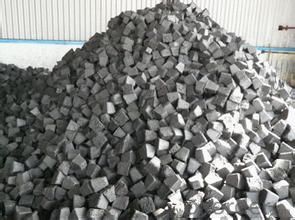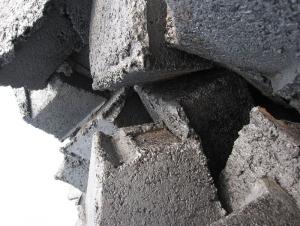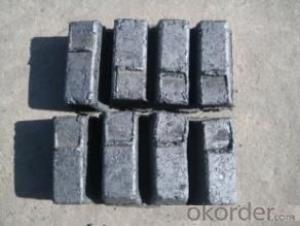Carbon Electrode Paste With Good And Stable Quality
- Loading Port:
- Lianyungang
- Payment Terms:
- TT or LC
- Min Order Qty:
- 20 m.t.
- Supply Capability:
- 800 m.t./month
OKorder Service Pledge
OKorder Financial Service
You Might Also Like
Spcifications
1for ferroalloy,calcium carbide manufacture
2HS 3801300000,YB/T5212-1996,ISO9001:2008
Product Description
Carbon Electrode Paste is a self-baking electrode used for ferroally production. Electrode Paste is added to the top of the electrode column in either cylindrical or briquette form. As the paste moves down the electrode column the temperature increase causes the paste to melt and subsequently bake forming a block of electrically conductive carbon. Electrode Paste is essentially a mix of Electrically Calcined Anthracite (ECA) or Calcined Petroleum Coke (CPC) with Coal Tar Pitch.
Carbon Electrode Paste Specification:
| PARAMETER UNIT GUARANTEE VALUE | ||||||
| Ash.( % ) | 4.0 max | 5.0 max | 6.0 max | 7.0 max | 9.0 max | 11.0 max |
| V.M (%) | 12.0-15.5 | 12.0-15.5 | 12.0-15.5 | 9.5-13.5 | 11.5-15.5 | 11.5-15.5 |
| Compress Strength. | 18.0 min | 17.0 min | 15.7 min | 19.6 min | 19.6 min | 19.6 min |
| Specific Resistance | 65 max | 68 max | 75 max | 80 max | 90 max | 90 max |
| Bulk Density | 1.38 min | 1.38 min | 1.38 min | 1.38 min | 1.38 min | 1.38 min |
Package:
In MT jumbo bag or as buyer's request
Picture:


- Q:How do you use carbon fourteen to measure the age?
- Then, carbon - 14 dating method is to determine the remains of ancient age? Originally, cosmic rays can produce radioactive carbon -- 14 in the atmosphere, and can enter all living tissue carbon dioxide and oxygen - synthesis combined, first for the absorption of plants, after the animal into a plant or animal. As long as they live. Continuous absorption of carbon - 14, to maintain a certain level in the body. When the organism dies, which will stop breathing carbon - 14, within their organization, with a half-life of 14 carbon began 5730 years of decay and gradually disappear. For any carbon containing material, as long as the determination of the remaining 14 of the content of radioactive carbon you can, that the age of 14. Carbon dating method is divided into conventional carbon - 14 dating method and carbon - 14 accelerator mass spectrometry dating two. At that time, since it is invented by Libby conventional carbon - 14 dating method, this 1950. The technology and application of methods have significant progress in the world, but its limitations are obvious, namely the time measurement must use a large number of samples and longer. Thus, carbon - 14 dating accelerator mass spectrometry technology developed. Carbon - 14 accelerator mass spectrometry dating method has unique advantages.
- Q:When will amines be fertilized?
- Carbon is the most commonly used varieties of amine fertilizer, with nitrogen and phosphorus fertilizer, fertilizer use, fertilizer is generally 120 days or so, the suitable conditions of temperature, moisture in the next 50 days after applying fertilizer best.Carbon amine is a white compound that is granular, plate-like or columnar crystalline. Because ammonium bicarbonate is a carbonate, it must not be placed with acids because the acid reacts with ammonium bicarbonate to form carbon dioxide, which causes ammonium carbonate to go bad. However, in the rural areas, ammonium carbonate and acid reaction are also used. The ammonium bicarbonate is placed in the vegetable greenhouse, and the greenhouse is sealed, and ammonium bicarbonate is placed at the top, adding hydrochloric acid. At this point, the amines react with hydrochloric acid to produce ammonium chloride, water, and carbon dioxide. Carbon dioxide can promote plant photosynthesis, increase vegetable production, and the resulting ammonium chloride can also be used as fertilizer again. Ammonium bicarbonate in the chemical formula of ammonium ion, is an ammonium salt, and ammonium salt and alkali can not be put together, so ammonium bicarbonate and sodium hydroxide or calcium hydroxide should not be put together
- Q:What is carbon dating and how does it work?
- Carbon dating is a scientific method used to determine the age of organic materials, such as plant or animal remains, by measuring the amount of radioactive carbon-14 present in the sample. Carbon-14 is a naturally occurring isotope of carbon that is constantly formed in the atmosphere through the interaction of cosmic rays with nitrogen atoms. Living organisms absorb carbon-14 while they are alive, and the level of carbon-14 in their tissues remains relatively constant. However, once an organism dies, it no longer takes in carbon-14, and the amount of carbon-14 in its remains gradually decreases over time through radioactive decay. By comparing the ratio of carbon-14 to stable carbon-12 in a sample, scientists can estimate the age of the organic material using known decay rates.
- Q:How can carbon capture and storage help reduce greenhouse gas emissions?
- CCS has the potential to make a significant contribution in the fight against greenhouse gas emissions. Its core process involves capturing carbon dioxide emitted from industrial activities or power generation, transporting it, and then underground storage in geological formations. To begin with, CCS can effectively reduce greenhouse gas emissions by capturing CO2 directly from major sources like power plants and industrial facilities. Without CCS, these sources would release CO2 into the atmosphere, exacerbating the greenhouse effect and further contributing to climate change. By capturing and storing this CO2, the negative impact on climate change is mitigated. Additionally, CCS allows for the continued use of fossil fuels, such as coal or natural gas, in a more environmentally friendly manner. These fuels are currently the main sources of energy for electricity generation and industrial processes. By implementing CCS, the emissions of CO2 from these fossil fuel activities can be significantly reduced, facilitating a gradual and economically feasible transition to cleaner energy sources. Moreover, the combination of CCS with bioenergy production creates a process known as BECCS. This involves using biomass, like crop residues or energy crops, to produce energy. The CO2 emitted during this bioenergy production is captured and stored, resulting in a net-negative emissions process. BECCS effectively removes CO2 from the atmosphere, offsetting emissions from other sectors. Lastly, CCS can play a crucial role in the decarbonization of hard-to-abate sectors, such as cement and steel production, where low-carbon alternatives are currently limited. By capturing and storing CO2 emissions from these sectors, CCS significantly reduces their overall greenhouse gas emissions and supports their transition towards more sustainable practices. In conclusion, the implementation of carbon capture and storage technology is essential in reducing greenhouse gas emissions. It directly captures and stores CO2 from major sources, allows for the sustainable use of fossil fuels, enables negative emissions through BECCS, and aids the decarbonization of challenging sectors. By incorporating CCS alongside other mitigation strategies, global climate goals can be achieved, and the battle against climate change can be fought effectively.
- Q:How does carbon impact the prevalence of tropical storms?
- Carbon, specifically in the form of carbon dioxide (CO2) emissions, plays a significant role in impacting the prevalence of tropical storms. The increase in atmospheric CO2 levels due to human activities such as burning fossil fuels, deforestation, and industrial processes has led to the phenomenon known as global warming. This rise in global temperatures has several implications for the formation and intensity of tropical storms. Firstly, warmer temperatures cause an increase in the evaporation of seawater, resulting in higher levels of moisture in the atmosphere. Moisture is a crucial factor in the development of tropical storms, as it provides the necessary fuel for their formation and sustenance. With more moisture available, the potential for tropical storms to develop and strengthen is enhanced. Additionally, rising global temperatures lead to the expansion of the warm tropical oceans, providing a larger area for tropical storms to form and intensify. This expansion allows for a greater exchange of energy between the ocean and the atmosphere, further enhancing the potential for storm development. Furthermore, elevated levels of CO2 contribute to ocean acidification, which has detrimental effects on marine ecosystems, including coral reefs. Coral reefs act as natural barriers that protect coastal areas from storm surges and waves generated by tropical storms. However, the acidification of oceans weakens and destroys these reefs, leaving coastal regions more vulnerable to the impacts of storms. Lastly, climate change caused by carbon emissions alters atmospheric and oceanic circulation patterns, which can affect the movement and tracks of tropical storms. Changes in wind patterns and ocean currents may cause storms to deviate from their traditional paths, leading to increased uncertainty and potential impacts on regions that are not typically prone to these events. In summary, carbon emissions and the subsequent global warming they cause have significant impacts on the prevalence of tropical storms. Increased moisture content, expanded warm ocean areas, weakened coastal defenses, and altered storm tracks are all consequences of rising carbon levels, which ultimately contribute to more frequent and intense tropical storms.
- Q:What are the carbon monoxide collection methods?
- It can only be collected by drainage. Carbon monoxide is not soluble in water. Because carbon monoxide is poisonous and the density is very close to the air, it can not be collected by exhaust air
- Q:What is the impact of carbon emissions on agriculture?
- Agriculture is significantly impacted by carbon emissions, with effects seen in both crop production and livestock farming. The primary consequence of increased carbon emissions is climate change, which has the ability to change weather patterns and temperatures. These alterations can disrupt the delicate balance necessary for successful agriculture. The rising temperatures caused by carbon emissions result in increased evaporation, which can diminish soil moisture and hinder crop growth. This leads to more frequent and severe droughts, causing water scarcity and reduced crop yields. Moreover, extreme weather events like floods, storms, and hurricanes become more common, causing extensive damage to crops and farmland. Another outcome of carbon emissions is the modification of atmospheric composition. Elevated levels of carbon dioxide (CO2) stimulate the growth of specific weeds and invasive species, which compete with crops for vital resources such as sunlight, water, and nutrients. This competition ultimately results in decreased crop yields and lower-quality produce. Furthermore, carbon emissions contribute to air pollution, including the formation of ozone. High levels of ozone can harm plant tissues and limit photosynthesis, thus reducing crop productivity. Livestock health is also negatively affected by ozone, leading to decreased growth rates and milk production. The impact of carbon emissions on agriculture extends beyond crop production to livestock farming. Changes in climate and temperature can adversely affect animal health and productivity. Heat stress becomes a significant issue, resulting in reduced fertility, lower milk yields, and increased vulnerability to diseases. Additionally, livestock require sufficient access to water and nutritious feed, which can become scarce due to droughts and heightened competition for resources. In conclusion, carbon emissions have a detrimental impact on agriculture, affecting both crop production and livestock farming. Climate change, altered weather patterns, and increased competition for resources all contribute to reduced yields, lower-quality produce, and decreased livestock productivity. It is crucial to address and mitigate carbon emissions to ensure the sustainability and resilience of the agricultural sector in the face of these challenges.
- Q:What are the 3K, 12K, UD, etc. in the appearance requirements of the carbon fiber bicycle? What's the difference?
- 3K 12K UD refers to the pattern of carbon fiber thickness, 3K pattern is the smallest of the above lattice minimum.The higher the number of K, the more tedious the process, the more expensive the cost, but unfortunately, the performance of large pieces of no help, just to meet psychological needs. The smaller the carbon fiber object, the smaller the grid, so that the force is better. The carbon fiber component of the remote control helicopter is the 3K pattern. My 12K version is on ArchitectureThere are some people say: UD carbon cloth is like carbon cloth, and there is a gap between the strength of carbon cloth, 3K carbon cloth is made of 3 thousand carbon fiber woven cloth, UD imitation carbon cloth is formed in parallel with carbon fiber tile free carbon cloth, and then cut into UD imitation carbon cloth needs finally, to make the same width, Zhumie into UD.
- Q:What is coal?
- Coal is a black or brownish-black sedimentary rock that is primarily composed of carbon, along with various other elements such as hydrogen, sulfur, oxygen, and nitrogen. It is formed from the remains of plants that lived and died millions of years ago, accumulating in swampy environments. Over time, the layers of plant material were subjected to high pressure and heat, resulting in the formation of coal. Coal is one of the most abundant fossil fuels on Earth and has been used as a source of energy for centuries. It is typically extracted from underground or surface mines and can be found in different forms, including anthracite, bituminous, sub-bituminous, and lignite, with varying carbon content and heating value. Due to its high carbon content, coal is primarily used for electricity generation and as a fuel for industrial processes. When burned, it releases energy in the form of heat, which is converted into electricity through steam turbines. However, burning coal also releases greenhouse gases and other pollutants, contributing to air pollution and climate change. In addition to its use as a fuel, coal is also used in the production of steel and cement, as well as in various industrial processes. It is a versatile resource that has played a significant role in the development of modern societies, but its environmental impact and finite nature have led to increased efforts to shift towards cleaner and more sustainable energy sources.
1. Manufacturer Overview |
|
|---|---|
| Location | |
| Year Established | |
| Annual Output Value | |
| Main Markets | |
| Company Certifications | |
2. Manufacturer Certificates |
|
|---|---|
| a) Certification Name | |
| Range | |
| Reference | |
| Validity Period | |
3. Manufacturer Capability |
|
|---|---|
| a)Trade Capacity | |
| Nearest Port | |
| Export Percentage | |
| No.of Employees in Trade Department | |
| Language Spoken: | |
| b)Factory Information | |
| Factory Size: | |
| No. of Production Lines | |
| Contract Manufacturing | |
| Product Price Range | |
Send your message to us
Carbon Electrode Paste With Good And Stable Quality
- Loading Port:
- Lianyungang
- Payment Terms:
- TT or LC
- Min Order Qty:
- 20 m.t.
- Supply Capability:
- 800 m.t./month
OKorder Service Pledge
OKorder Financial Service
Similar products
New products
Hot products




























